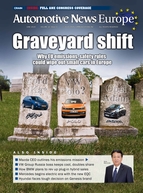BorgWarner Chief Technology Officer Hakan Yilmaz says the propulsion specialist is poised to gain from Europe's rapid shift to electrified powertrains, a move that is being driven by tougher EU emissions standards that start to take effect next year.
Yilmaz, who joined BorgWarner in 2018 after more than 15 years with Robert Bosch, says the supplier's products will help automakers reach both this short-term and midterm CO2 targets. He explained why in an interview with Automotive News Europe Managing Editor Douglas A. Bolduc.
What products in your portfolio give you the greatest hope for the future?
If you are talking about immediate impact, we see a massive volume shift toward 48-volt and high-voltage hybrids, driven by the tougher CO2 legislation [that starts to come into effect in Europe next year]. There, our primary focus is on the 48-volt side. Secondly, we are seeing great demand for our P2 On-Axis drive module [which converts a combustion-powered vehicle into a hybrid without changing the engine or transmission.]. It is an easy way of achieving hybridization because all you need to do is open up a space of about 6 inches (about 150mm) between your engine and transmission and packaged it in.
Is the solution scalable?
Yes. You can start with a 48-volt hybrid P2 On-Axis for the 2020-22 timeframe and on the same architecture in 2025 you can upgrade that to a high-voltage solution. For 2030 [when even tougher EU CO2 rules take effect], you can upgrade that system by adding some batteries and downsizing your transmission to come up with a plug-in hybrid. That means if you add the P2 architecture to your propulsion system now, it is there to stay for at least a decade. This is why we are seeing such strong growth.
Could you quantify that?
Eighteen customers have ordered or are in development with us on pieces of the P2 that they will integrate in-house. Two of those customers have bought the complete P2 module. Our first launch is in China at the end of next year. And, we are not talking about a few thousand units. We are talking about multiple hundreds of thousands of units.
How crucial was the 2015 purchase of alternator and starter supplier Remy International to get to this level with hybrids?
Within four to five years we are introducing to the market an end product that is fully integrated and very sophisticated. I think there is only one other supplier out there that can do this in-house.
How are you positioned when it comes to providing components to full-electric vehicles?
With the addition of our planned partnership with battery module and pack supplier Romeo Power Technology we will have the entire ecosystem all the way from plug to wheel. Every area where the EV passes through we have a product.
How do you decide what to add and cut from your parts portfolio?
We have a very structured and systematic portfolio management team that looks at the market potential and the market growth. Then we ask ourselves: Can we keep the lead position in the market? Is the market growing? We are investing heavily into areas where we think we can grow with the market or beat the market. And, we have some products moving down, completing their life cycle, like our thermostat business, and we decide to divest. As a publicly traded company we cannot get emotionally attached to our products. We have to be very pragmatic. If we don't see the growth and it doesn't fit our future portfolio we find a better owner for that business. We are very successful in mergers and acquisitions.
What spaces do you need to fill?
Our primary focus is to build up our scale and capabilities in power electronics. This includes inverters, on-board chargers the entire power electronics system. We are looking at organic and inorganic options every day.
How do your turbochargers fit into this electrified future?
Today we are seeing a massive move toward high-volume hybridization. This is great for us because we are growing about two times faster than the market itself. And, the hybrid architectures with the biggest growth are very synergistic with turbos. Therefore, in Europe especially, turbochargers seem to be here to stay and will continue to grow with the hybrid market.
Is that true even with plug-in hybrids and electric vehicles?
You might need fewer turbos but even so most of the automakers are announcing that they will keep their turbo engines even with plug-in hybrids because European customers are used to the performance they get with a turbo. You can downsize your engine and leverage the electrical power to compensate, and that gives you an additional fuel economy benefit.
Which markets will lead the way?
It will be Europe and China. They are very similar. We were seeing China as the lead for electrification until last December when the European legislators decided to push for similar CO2 targets [which take effect in 2030] as in China. So when we do fleet simulations we see similar plug-in hybrid and EV penetration rates in China and Europe in the next 10 years, driven by the demand to reduce CO2.
Do all of these changes require you to find new Tier 2 and Tier 3 suppliers?
The products that we have today are very different than the product we had five years ago. And the products that we will have in the next five years will be very different than what we have now. Therefore, we have to adapt our supplier base continuously otherwise we will be behind. In the electrification market if you are not one of the first three in the market before the market consolidates you are out. It is very competitive. We live through this with turbochargers. Right now the turbocharger market is dominated by a handful of suppliers and we are one of them because we were so quick to market.

